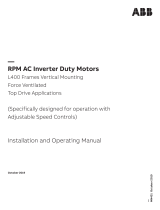
CONNECTIONS
WIRING: Use sufficiently large insulated wire to connect the generator set to the load. The gauge
of the wire will depend largely on the distance, the permissible voltage drop, and the size and type of
load. If you are not sure of the gauge wire needed for your application, consult a competent
electrician.
FRAYED, CUT, BROKEN, LOOSELY CONNECTED, OR IMPROPERLY
SIZED POWER CORDS OR WIRES CAN CAUSE EQUIPMENT DAMAGE,
FIRE, SEVERE INJURY OR DEATH. INSPECT AND MAINTAIN ALL
POWER CORDS ON A REGULAR BASIS.
GROUNDING: If grounding is necessary in your application according to National Electric Code
and/or local codes, drive a 3/4" or 1" pipe into the ground as close to the generator
Set as is possible. This pipe must penetrate moist earth (minimum of 8 feet). Connect a ground clamp
to this pipe and run a No. 10 wire or larger from it to the ground stud on the generator set.
Do not connect the ground wire from the generator set to a water pipe or a ground used by a radio
system.
IMPROPER GROUNDING CAN CAUSE EQUIPMENT DAMAGE, SEVERE
INJURY OR DEATH. INSPECT AND MAINTAIN THE GROUNDING
SYSTEM IN ACCORDANCE WITH ALL APPLICABLE CODES.
CONNECTIONS TO HOUSE WIRING: Any electrical generator that is temporarily
connected to a
building or home (where the building is also supplied electricity by a local utility) shall be connected
only by a competent electrician and only after the main service entrance switch has been
disconnected and locked open
. This will isolate the building's electrical system from the local utility's
electrical transmission wires and prevent the hazard of electrical back-feed to utility service workers.
Any generator set that is permanently
connected to a building or home (where the building is also
supplied electricity by a local utility) shall be connected only by means of a double- throw transfer
switch. This will isolate the building's electrical system from the local utility's electrical transmission
wires and prevent the hazard of electrical back-feed to utility service workers.
DO NOT CONNECT THIS GENERATOR SET TO ANY BUILDING’S ELECTRICAL
SYSTEM UNLESS YOU USE AN APPROVED TRANSFER SWITCH OR THE MAIN
SERVICE ENTRANCE SWITCH HAS BEEN DISCONNECTED AND LOCKED OPEN.
ANY TEMPORARY OR PERMANENT WIRING CONNECTIONS MADE BETWEEN A
GENERATOR SET AND AN EXISTING ELECTRICAL SYSTEM MUST ONLY BE
DONE BY A QUALIFIED COMPETENT ELECTRICIAN. IMPROPER WIRING/
CONNECTIONS COULD CAUSE EQUIPMENT DAMAGE, PROPERTY DAMAGE,
INJURY OR DEATH.
CHECK ALL NATIONAL ELECTRIC CODES AND ALL LOCAL CODES IN REGARDS TO YOUR SPECIFIC
APPLICATION. ANY NATIONAL ELECTRIC CODE OR LOCAL CODE WILL TAKE PRECEDENCE OVER
ANY OF OUR GUIDELINES OR RECOMMENDATIONS.
- 2 -





















